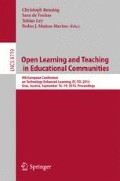Abstract
The proposal draft is the first step to achieve a university degree by students in many educational institutions. This proposal is transformed into a thesis after several revisions by an academic adviser. Each proposal must comply with requirements of institutional guidelines. In this paper we present an analyzer to identify the sequence of concepts within the proposal drafts in Computer Science and Information Technologies, with the goal of aiding students to improve their drafting. We propose four methods integrated into our analyzer, which were designed considering the transitions of grammar constituents (subject and object) in the sections of Problem Statement, Justification and Conclusions. We developed the methods from corpora analysis, validating them further. Moreover, we found that the sequences of concepts correspond to what is expected in the different sections.
Access this chapter
Tax calculation will be finalised at checkout
Purchases are for personal use only
Preview
Unable to display preview. Download preview PDF.
References
Davis, J., Liss, R.: Effective academic writing. The essay, vol. 3. Oxford University (2006)
Webber, B., Egg, M., Kordoni, V.: Discourse structure and language technology. Natural Language Engineering 18, 437–490 (2011)
O’Rourke, S., Calvo, R.: Analysing Semantic Flow in Academic Writing. In: Proceedings Conference on Artificial Intelligence in Education: Building Learning Systems that Care, pp. 173–180. IOS Press, Amsterdam (2009)
Barzilay, R., Lapata, M.: Modeling local coherence: An entity-based approach. Computational Linguistics 34, 1–34 (2008)
Elsner, M., Charniak, E.: Brown Coherence Toolkit. Brown University (2007), http://cs.brown.edu/~melsner/manual.html
Gonzalez-López, S., López-López, A.: Assisting Students in Writing by Examining How Their Ideas are Connected. In: Di Mascio, T., Gennari, R., Vitorini, P., Vicari, R., de la Prieta, F. (eds.) Methodologies and Intelligent Systems for Technology Enhanced Learning. AISC, vol. 292, pp. 9–18. Springer, Heidelberg (2014)
Author information
Authors and Affiliations
Editor information
Editors and Affiliations
Rights and permissions
Copyright information
© 2014 Springer International Publishing Switzerland
About this paper
Cite this paper
González-López, S., López-López, A. (2014). Analysis of Concept Sequencing in Student Drafts. In: Rensing, C., de Freitas, S., Ley, T., Muñoz-Merino, P.J. (eds) Open Learning and Teaching in Educational Communities. EC-TEL 2014. Lecture Notes in Computer Science, vol 8719. Springer, Cham. https://doi.org/10.1007/978-3-319-11200-8_36
Download citation
DOI: https://doi.org/10.1007/978-3-319-11200-8_36
Publisher Name: Springer, Cham
Print ISBN: 978-3-319-11199-5
Online ISBN: 978-3-319-11200-8
eBook Packages: Computer ScienceComputer Science (R0)

